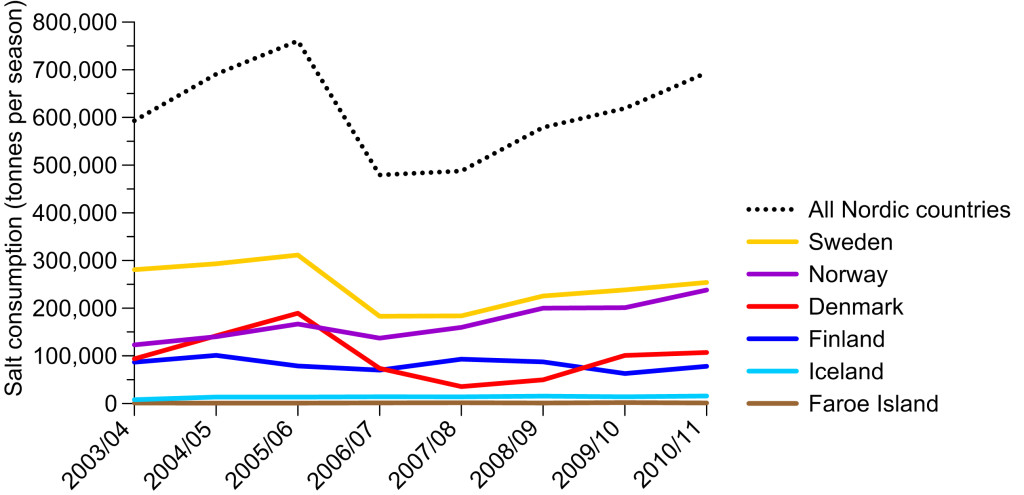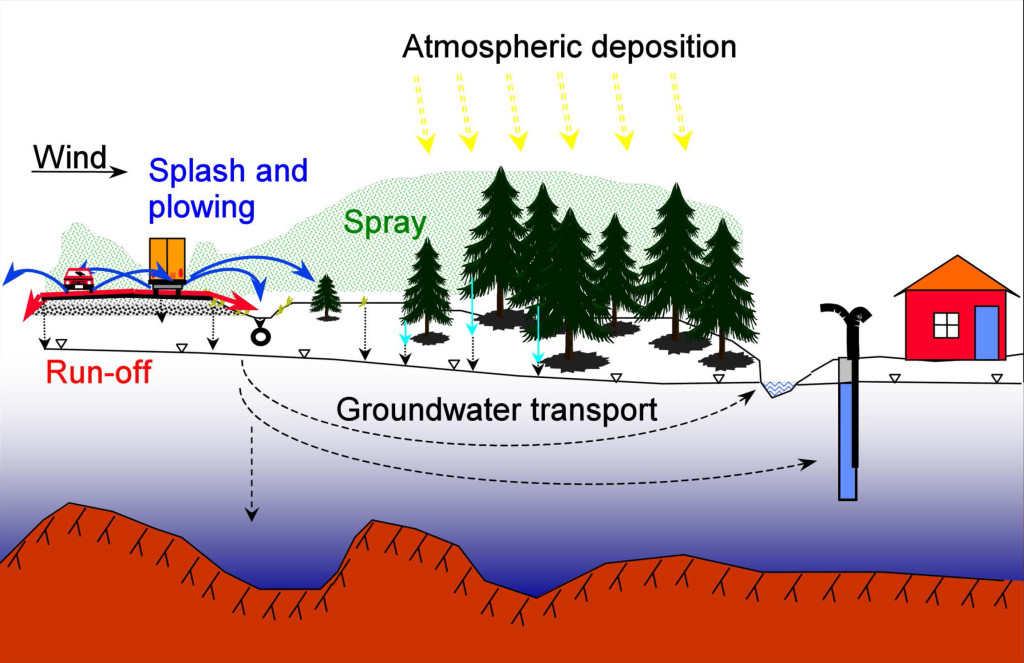The purpose is to develop a model for residual salt to be implemented. The model will be capable of calculating the residual salt in real time or predicting the development of residual salt on the road after spreading, by taking traffic, road and weather parameters into consideration.
Defining the conceptual model
Once the salt is spread on a road, it is influenced by many processes and factors. Figure 1 shows a principal sketch of a model describing the processes.
The model assumes that there might be mass in the form of three elements on road:
1. Water
2. Brine
3. Undissolved salt
The following processes are identified that may bring mass in and out of the system:
1. Spread of dry salt
2. Spread of brine
3. Blow-off
4. Run-off
5. Splash + spray-off
6. Evaporation of liquid
7. Condensation of moisture
8. Precipitation in the form of rain, sleet or snow
In addition, two processes have been identified which change the mass of the various types of elements within the system, i.e. the water, brine or undissolved salt:
9. Dissolution
10. Crystallization
The project team has identified all the factors and are well known with all the processes occurring on road surface.
Benefits of residual salt model
When the researchers succeed in finding a solid model of residual salt amount after a given time or traffic crossing, the possibilities are considerable excessive, including reducing pollution along the road, financial gain and effective workflow for winter crew.
Environmental conditions
In season 2010/11, the salt consumption on the Nordic roads was over 690,000 tonnes. The amounts vary depending on winter’s harshness. Previous environmental assessments have concluded that large quantities of the salt ends up in verges. Part of the salt also adheres to vehicles and surrounding structures such as bridges, besides being very harmful to the environment.
Furthermore, road salt cause increased chloride concentration in groundwater.
The same studies, also confirmed by the transport sector, indicate that road salt is very aggressive against constructions, and in particular, corrosive safety features of vehicles such as the braking system. Knowledge of the “residual salt” will help winter crew to salt only where it is needed.

Table 1: Annual salt consumption in the Nordic countries. (Source: Winter service in the Nordic countries in 2011)
Economic benefits
Road salt is traded today to a market of approx. 55-65 €/tonnes (source: Danish Road Directorate). The price is virtually the same on the Nordic market. Using table 1, the Nordic road authorities uses somewhere between 34-40 M€/year on road salt.
An estimate by Danish Road Directorate reveals that a callout for preventive salting on Danish roads will cost road authorities about 533 K€. In Denmark, the average call-outs/year is about 100. Multiply with the cost of salting, this summing up to 53 M€/year nationwide. The amount is in addition to costs associated with operation and maintenance of equipment and crew.
It is obvious that if the parameter “residual salt amount” can help winter crew to prevent even one single salting, thus the society has saved 533 K€.
The project MORS II will continue in the second period during 2013-2015.
Text:
Skuli Thordarson, ICERA, Iceland
Göran Blomqvist, VTI, Sweden
Mats Gustafsson, VTI, Sweden
Michel M. Eram, DRD, Denmark
 Contact: Contact:Michel M. Eram me5@vd.dk The Danish Road Directorate |








Follow us: